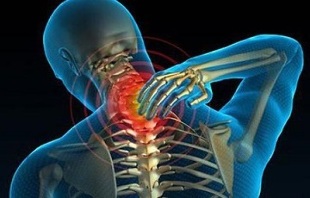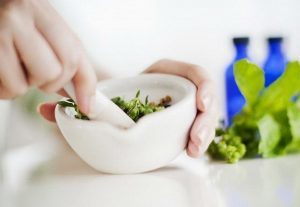
Cervical osteochondrosis is a progressive disease characterized by deformation and structural changes of the intervertebral disc.
Cervical osteochondrosis has recently become more common, which can be explained by the spread of an inactive lifestyle (driving, sitting at a computer).
Unlike the thorax and lumbar, cervical osteochondrosis occurs more frequently, which is caused by the anatomy of the cervical spine. The fact is that in the neck area of the vertebrae are quite close to each other and their skeletal muscles are less developed, which causes the transfer of the vertebrae even with a small load in the neck area, and, as a consequence, for compression of blood vessels and nerves.
Causes of cervical osteochondrosis
Relationships - cervical osteochondrosis, dizziness, fear, tension and depression.
The causes of manifestations and deterioration of cervical and vertebral osteochondrosis are no less relevant are human mental factors - these are stress, fear, anxiety, frequent or persistent stressful situations, which are often accompanied by internal stresses that arise.
Our spine, including the cervical part, is made up of 24 vertebral and intervertebral discs (cartilage), and to keep this whole structure strong and strong, the spine is tied with many muscles and ligaments that form a corset. A very important role in this design is played by the intervertebral disc, which allows the vertebrae to move relative to each other, thanks to the relief that occurs.
When the disc or spinal cord is damaged (structural changes due to metabolic disorders), osteochondrosis occurs, named after the affected area: cervical, thoracic and lumbar osteochondrosis.
In cervical osteochondrosis, the nerve roots that extend from the spinal cord are pinched and the ducts are compressed, which interferes with blood flow. because, in a tense muscle, the blood is difficult to move. Of course, the blood supply to the brain is also disrupted, as a result of which oxygen starvation occurs.
In addition, all these nerves that come out of the spinal cord are connected to our internal organs and therefore, their work is also disrupted.
Cervical osteochondrosis can also be caused by:
- intervertebral disc injury;
- lifting weights;
- incorrect posture;
- hypothermia, draft;
- improper procedures are performed, such as massage, etc.
- overeating, overweight - excessive stress on the spine;
- spicy, salty use exacerbates osteochondrosis;
- congenital or acquired scoliosis, kifosis, lordosis;
- prolonged exposure to vibration - working with construction machinery, driving a car, etc.
- uncomfortable beds, feather beds, large pillows, therefore, the position of the neck in sleep is incorrect;
- hereditary tendencies;
- loads on the spine, not only strong, but, for example, monotonous;
- pathology of musculoskeletal apparatus;
- temporomandibular joint asymmetry, its injury, chewing habits, malocclusions;
- tight and uncomfortable bra straps, tight collars;
- cooperates with heavy movements of the same type (especially when bending half forward): sawing-splitting firewood, gardening with a shovel, with a hoe, washing on boards, inhaling dust and the like.
Symptoms of cervical osteochondrosis
Symptoms of cervical osteochondrosis directly depend on the target. Accordingly, a group of syndromes participating in the disease are distinguished:
- Radicular syndrome.Radicular syndrome occurs when the nerve root in the cervical area is pressed (pinched nerve). It is also called cervical radiculitis. The pain that occurs in the neck is spread down and can go down to the scapula and even to the outside of the forearm to the fingers. Among the symptoms of cervical osteochondrosis, in some cases, there is tingling in the forearms, hands or fingers, excitement, the effects of goose bumps.
- Unpleasant reflex syndrome.In the event of reflex-reflex syndrome, symptoms of cervical osteochondrosis may include acute burning pain in the neck or occiput, which occurs when moving after a static condition (with sharp rotation of the head, when sneezing, after sleeping). Pain can radiate to the shoulders and chest.
- Heart syndrome.The symptoms of cervical osteochondrosis in this syndrome largely coincide with the symptoms of angina pectoris. In this case, it is very important not to make mistakes in the diagnosis. With cardinal syndrome, the nature of the pain is paroxysmal and prolonged (up to several hours). Increased pain occurs with sudden movements caused by coughing, sneezing, and sharp head rotation. Often there is the appearance of tachycardia and extrasystoles with the background of complete absence of signs of circulatory disorders.
- Vertebral artery syndrome.In this case, cervical osteochondrosis is accompanied by symptoms such as throbbing or burning headaches, which most often attack the superciliary area, back of the head, temples, dark. Pain, as a rule, practically does not stop, and only in some cases has a paroxysmal character. Increased pain occurs with movement or after prolonged in an uncomfortable position.
There is a possibility of hearing and vision impairment (decreased hearing and vision, tinnitus, disorders of the vestibular apparatus, eye pain). Against the background of general weakness of the body, nausea or loss of consciousness is possible.
With the above conclusion, we can distinguish some of the most characteristic symptoms of cervical spine osteochondrosis:
- constant pain in the neck, spreading to the shoulder girdle, ears and eyes, the back of the head and does not stop even at night;
- pain in hands, forearms, shoulders, worsening even with a slight load;
- weakness of muscle strength and decreased sensitivity of the hands, arms, fingers, as well as difficulty in their movement;
- neck pain when turning and tilting head;
- neck muscles, feeling lying down in the morning;
- burning, numbness, tingling in the legs or arms;
- widespread headache with primary localization in the occiput;
- dark eyes, tinnitus, numbness of the tongue, dizziness, with sharp head rotation - fainting,
- decreased visual and auditory acuity;
- proliferation of connective tissue in the cervical spine;
- pain in the heart.
Remedy for cervical osteochondrosis
Cervical osteochondrosis is a complex disease that requires long-term, systematic and gradual treatment. Therapy aims to relieve pain and combat the inflammatory process in the affected area.
Patients are given analgesics. Recently, non-steroidal anti-inflammatory drugs have become increasingly popular in the treatment of degenerative-dystrophic diseases of the spine, which effectively relieves pain syndrome and reduces the activity of inflammatory processes.
In the treatment of cervical osteochondrosis, the appointment of chondroprotectors is indicated - a drug that slows down the destruction of cartilage tissue. Many doctors believe that the use of these drugs also encourages the regrowth of cartilage tissue.
The use of topical ointments and gels containing irritants or non-steroidal anti-inflammatory drugs is ineffective. Medicinal substances that are part of their composition are unlikely to reach the affected area due to skin barrier, subcutaneous tissue and muscle. Even so, it makes sense to use this external agent, because when applied to the skin, a neck massage is performed.
To improve the regenerative and metabolic processes of the affected nerve roots, patients are prescribed group B vitamins. Often, doctors recommend to patients a combination of vitamin preparations, given intramuscularly.
Traditional methods for treating cervical osteochondrosis
Folk remedies can certainly not be eliminated - cervical osteochondrosis with its symptoms can be treated at home with essential oils, herbs, fats, roots and poisons. They are combined with alcohol, iodine and turpentine, and have anti-inflammatory and heating agents that are effective enough for external and internal use.
Cervical osteochondrosis therapy
Selery Solutions. Grate celery root on the best grater, squeeze the juice. Take celery juice for cervical osteochondrosis, symptoms and treatment at home three times a day for one tablespoon before meals.
Less concentrated version of the medicine - for 1 tablespoon of juice 100 ml of boiling water, leave for a few hours and take one tablespoon of solution an hour before meals 4 times a day.
You can also use the roots themselves instead of juice - pour 3 grams of roots into 0. 5 liters of boiling water, leave for a few hours until completely cool and drink 20 ml before each meal.

Greeting leaf medicine. In an enamel pot, pour 12 grams of bay leaf with 300 ml of cold water, boil for five minutes. Leave for three hours, drain. Throughout the day, between meals, take an infusion with a small sip. Drink the rest before bed. Continue to take the medicine for four days, rest for a week and repeat the course. For prevention, repeat the course every spring.
Herbal accumulation of cervical osteochondrosis. Grind and mix 100 grams of chamomile, parsley, hops and oregano, add 100 grams of nettle leaves and 200 grams of burdock root. Mix with a thermos, pour 1. 5 liters of boiling water. Leave for three days. Drink strained solution in one tablespoon twice a day - in the morning and evening. Store in a cool, dark place.
Rubbing
Red pepper medicine.Finely chop two hot red chillies, pour into a tightly closed container and add 200 ml of vegetable oil. Close tightly with a non-metallic lid. Leave in a dark, warm place for five days. Rub into the affected area with gentle movements twice a day. There is no need to take a lot of funds at once, as it can burn a lot. The effect of the product is warming, blood circulation is improved.
Butter based.Mix the eggs with a tablespoon of vinegar, add a tablespoon of flour and 100 grams of softened butter. Leave the product for a few days in a dark place, remove the film formed on the surface of the mixture and rub it into the skin in the area of cervical osteochondrosis during massage. Store the prepared mixture no more than 3 days.
Compress
Burdock leaves and carrots have proven themselves to be compresses. They are baked with boiling water, rubbed into the damaged area and stored for several hours, wrapped in a cotton cloth. Repeat 10 times daily. Repeat 2-4 times a year.
Therapeutic exercises for cervical osteochondrosis
This exercise will help overcome existing cervical spine osteochondrosis, and as prophylaxis. Gymnastics for cervical osteochondrosis for preventive purposes can be done at night at home, but it is better to use short breaks at work for this (this is a recommendation for those who have an inactive job). Gymnastics with cervical osteochondrosis does not require much time, but gives positive results, and is fast enough.
- Exercise 1.Sit upright, tilt your head back and try to reach the right shoulder with the right ear, then return to the starting position. Exercise is done slowly and smoothly, muscles are not tense. Perform five repetitions for each side.
- Exercise 2.Sitting upright, face looking forward, chin slightly raised. Slowly and smoothly turn the head to the right - as much as possible. Return to starting position and turn left. Repeat 5 times in each direction.
- Exercise 3.Place your palms on your forehead and press your head on it, while the palms should be in the same place, which is to withstand the pressure. During stress with the head, you need to stretch the neck muscles. Slowly count to 5 for yourself and relax. Repeat 3 times.
- Exercise 4.Exercises are similar to Exercise 3, only the palms (or two palms) should be placed on the back of the head and with them to press the palms. Tension must be maintained, counting to 5. Repeat 3 times.
- Exercise 5.Exercise is similar to Exercise 3, but in this case, place your right palm on the right temple and press your head to the palm of your hand. Tension must be maintained, counting to 5. Repeat 3 times. Then do the same, place the left palm on the left temple - repeat 3 times.
- Exercise 6.Sit upright, tilt your head back a little and then slowly, with tension, as if overcoming obstacles, lower your head down, press your chin to your chest. Repeat 5 times.
- Exercise 7.Sit up straight, lower your head down and make your head slowly turn right and left - 5 times in each direction. In this case, the head remains lowered.
Gymnastics for cervical osteochondrosis should not include rotation of the head without the support of the hands, especially at times when the neck feels tense and sore.
Self-massage for cervical osteochondrosis

Self-massage does not hurt, this is the main treatment at home. The main requirement is a frugal regime. You can not use excessive force, the procedure is performed exclusively with your fingers. You can do this all day at least. When exercising, it is recommended not to bend or tilt the neck to the side.
Need to start from the upper cervical vertebrae and lower the massage area gradually. The movement should be spun or smooth, from center to edge, from top to bottom. If the muscle in the cervical area is stiff, it can be kneaded separately. Remember the symmetrical load. The time to massage the right and left sides is almost the same. It is not possible to cure the disease completely by massaging yourself, but it is very possible to slow the disease and speed recovery.
Nutrition for cervical osteochondrosis
With osteochondrosis of the cervical spine, doctors advise eating in small portions at least 5 times a day. Eat cooked or steamed food. Drink at least 1. 5 liters of water a day. Season salad with olive oil. Avoid cigarettes and alcoholic beverages.
Include the following products in the menu:
- lean meats: beef, rabbit, chicken;
- vegetables and fruits: cucumber, tomato, carrot, onion, pepper, beet, cabbage, broccoli, celery, eggplant, avocado, spinach, water lettuce;
- dairy products: cheese, cottage cheese, milk;
- seafood: fish, lobster, oysters, crabs;
- dishes with gelatin: jelly, jelly meat, aspic from fish;
- nuts and seeds: almonds, hazelnuts, sunflower seeds;
- mushrooms, eggs, cereals.
Try eating less sugar, grapes, broth. Eliminate salty and smoked foods, flour products, hot spices from the diet.
Prevention of cervical osteochondrosis
As always, proper prophylaxis will help prevent cervical spine osteochondrosis, but, of course, all physical exercise must be used regularly, otherwise there will be little benefit from "periodic" exercise.
Remember the simple rule:
- frequent sports for sports, especially swimming, water aerobics, gymnastics for stretching and flexibility of the spine are also suitable to prevent osteochondrosis, which can be practiced at home;
- Eat more foods high in calcium and magnesium. These are fish, peas, legumes, beans, cheese, herbs, but it is better to stay away from sugar, flour, smoked, spicy;
- choose a good orthopedic mattress and a pillow that fits your neck, supporting the head in the correct anatomical position during sleep (yes, your favorite bottom pillow will not go away with spinal problems! ).
- during inactive work, at least several times a day, do a set of special therapeutic exercises





































